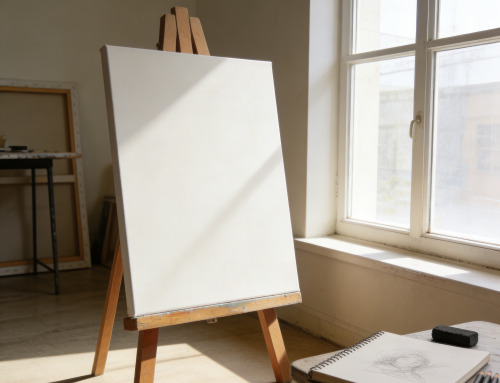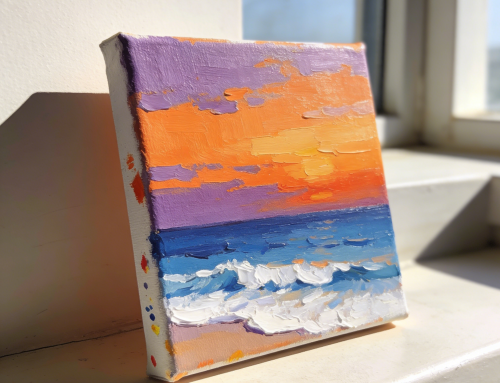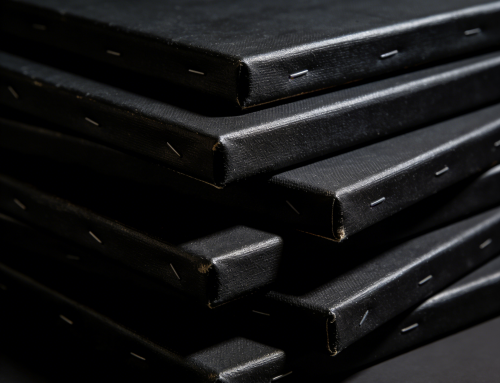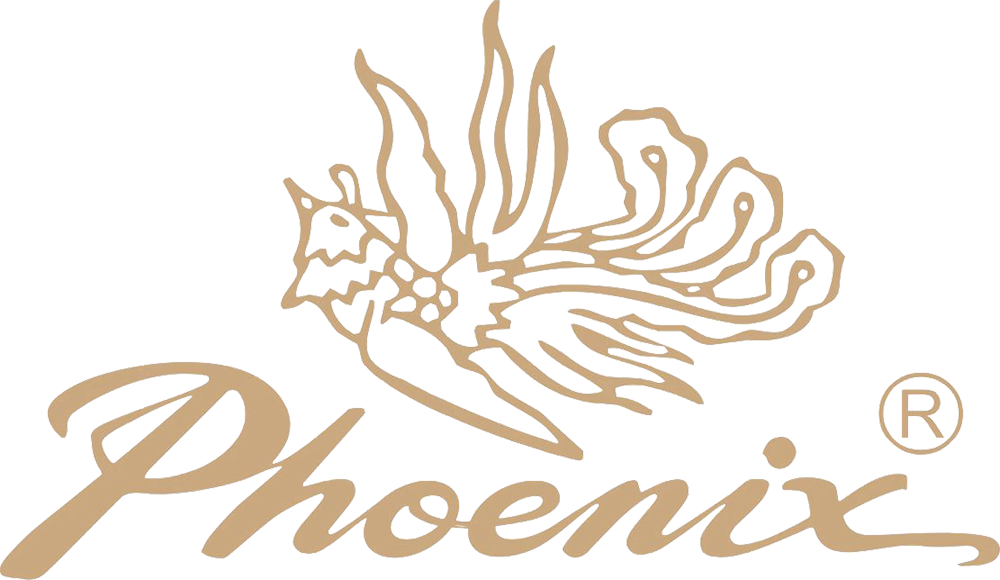Prefect Guide to Choose Stretched Canvas for Artists
Imagine stepping into your studio, the faint scent of flax fibers lingering in the air as you unroll a premium linen canvas, ready to stretch it taut over a sturdy canvas frame. This responsive surface, with its subtle spring and textured weave, becomes the foundation for your creative expression. But in a market flooded with options, how do you navigate the world of stretched canvas to find the perfect fit?
Understanding Basic Stretched Canvas
Stretched canvas refers to a woven fabric—typically cotton duck or linen—tightly pulled over a wooden or aluminum frame, secured with staples or tacks to create a drum-like tension. This construction provides a responsive “bounce” that enhances brushwork, making it a staple for oil and acrylic painters since the Renaissance era, when artists shifted from rigid wood panels for greater portability and scale.
Professional terminology is key to grasping its nuances. “Cotton duck,” for instance, denotes a heavy, plain-woven cotton fabric, often measured in ounces per square yard (oz), such as 10oz for medium weight or 12oz for heavier duty. In contrast, “linen” is derived from flax fibers, celebrated for its superior tensile strength and elasticity, quantified in grams per square meter (gsm)—examples include 316gsm for lightweight options or 475gsm for robust weaves. The “weave” describes the fabric’s texture: extra-fine for smooth glazing techniques, medium for versatile grip, or rough for pronounced tooth in impasto applications.
Construction involves “stretcher bars”—kiln-dried wooden or aluminum profiles with bevelled edges to prevent ghosting imprints on the painting surface. Larger formats incorporate “crossbars” for reinforcement, preventing warping under tension. Securing methods include side-tacking for traditional looks or back-stapling for clean, gallery-ready edges. Artists often use “canvas pliers” to achieve even pull, ensuring the grain remains square to avoid distortions.
Priming is essential, sealing the fabric to prevent oil penetration and providing a ground for paint adhesion. “Universal primed” canvases feature acrylic gesso, suitable for both oils and acrylics, applied in multiple thin coats—typically triple primed for artist-grade quality to minimize cracking. “Oil primed” options require separate sizing (e.g., with rabbit skin glue or synthetic alternatives) and cure over weeks, ideal for oil-only works. Transparent or clear-sized priming preserves the natural fabric color for toned grounds. Additional custom grounds, like watercolour or encaustic preparations, can modify absorbency.
At Phoenix Arts, our linen canvases exemplify these standards, with options like ultrafine weaves (260gsm) for detailed work or master linen (650gsm) for heavy-duty applications, all available in rolls up to 2.10 x 10 meters for bespoke stretching.
How to Select Perfect Stretched Canvas Sizes
Size classification is arguably the most critical aspect of stretched canvas selection, as it directly impacts composition, portability, workflow, and visual impact. Drawing from established categorizations in the art supply industry, stretched canvases are typically grouped into small, medium, large, and oversized formats, often aligned with standard proportions for easel compatibility and framing ease. These classifications evolved from traditional artistic needs—small for studies, large for statements—while modern options include custom depths and shapes for contemporary practices.
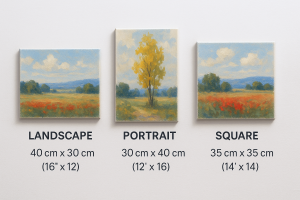
Professional parameters for sizes include linear dimensions (in both metric cm and imperial inches), proportions (landscape, portrait, square), profile depths (e.g., 16mm slim for wall-hugging display or 36mm gallery-wrap for sculptural presence), and reinforcements like crossbars for stability in larger pieces. Weave density (threads per cm) and gsm weight also tie into size suitability—finer weaves (e.g., 18 threads/cm) for small, smooth surfaces; coarser (10.5 threads/cm) for large, textured ones. Priming layers scale with size too: triple priming for expansive formats to combat environmental stresses.
Standard Size Classifications
Stretched canvases are classified by scale to match project intent, with examples from Phoenix Arts’ linen range illustrating practical applications:
- Small Formats (Up to 40×50 cm or 16×20 inches): These compact sizes foster intimacy and experimentation, ideal for preliminary sketches, detailed studies, or portable setups like plein air painting. Common dimensions include 20×25 cm (8×10 inches) for quick portraits or 30×40 cm (12×16 inches) for exploratory abstracts. Their lightweight profile (often 20mm depth) makes them easy to transport, as many artists note in online forums—perfect for travel kits or wholesale educational packs. In linen, opt for ultrafine weaves (260gsm, 195 threads/sq cm) to maintain subtlety without overwhelming the limited space. Advantages include affordability and quick turnaround; however, they limit gestural freedom.
- Medium Formats (50×60 cm to 80×100 cm or 20×24 to 30×40 inches): Striking a balance between manageability and expressive potential, these are staples for studio work, gallery submissions, and professional series. Examples: 50×70 cm (20×28 inches) for half-figure compositions or 60×80 cm (24×32 inches) for dynamic landscapes. Depths range from 28mm for standard framing to 36mm for gallery-wrap styles, where the image extends over edges for a frameless aesthetic. Linen’s low expansion rate excels here, with Belgian options (400gsm, medium grain) providing versatile tooth. Crossbars are optional but recommended for humidity-prone environments, ensuring even tension.
- Large Formats (100×120 cm to 150×200 cm or 40×48 to 60×80 inches): Geared toward immersive, statement artworks, these sizes demand presence and are favored for exhibitions or commissions. Popular picks: 90×120 cm (36×48 inches) for abstract expressions or 120×150 cm (48×60 inches) for narrative scenes. Reinforcements become essential—crossbars fitted inside stretcher bars prevent bowing, while heavier gsm (e.g., 450gsm Linen Dream series) counters sagging. Profile depths often hit 40mm+ for added dimension, and triple universal priming seals against cracking. Portability dips, but linen’s flexibility allows rolling for transport if unframed.
- Oversized or Monumental (Over 150 cm or 60 inches in any dimension): Reserved for installations, murals, or ambitious projects, these bespoke formats push boundaries. Examples include 200×300 cm for environmental pieces, often custom-stretched from rolls. Aluminum stretcher bars are preferred for lightweight strength, reducing overall weight by up to 30% compared to wood. Parameters like 650gsm master linen with coarse weaves (10.5 threads/cm) provide maximum grip for heavy media, and multiple crossbars ensure structural integrity. Custom options abound, with lead times of 10-18 days for wholesalers.
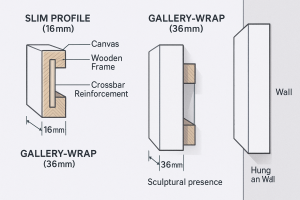
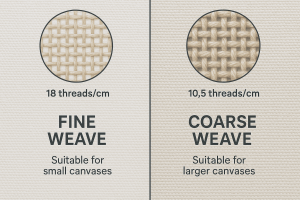
To aid selection, consider this reference table inspired by industry standards:
| Classification | Example Sizes (cm/inches) | Profile Depths (mm) | Best Weaves/GSM | Key Uses | Considerations |
|---|---|---|---|---|---|
| Small | 20×25 (8×10), 30×40 (12×16) | 16-20 | Ultrafine/260gsm | Studies, travel | High portability, fine details |
| Medium | 50×70 (20×28), 60×80 (24×32) | 20-28 | Medium/400gsm | Studio, galleries | Balanced handling, versatile |
| Large | 90×120 (36×48), 120×150 (48×60) | 28-36 | Coarse/450gsm | Statements, exhibits | Crossbars needed, impactful scale |
| Oversized | 200×300+ (80×120+) | 36+ | Heavy/650gsm | Installations | Custom, aluminum frames for stability |
Proportions and Shapes
Beyond scale, classifications incorporate proportions to guide visual harmony. “Landscape orientation” (wider than tall, e.g., 30×40 cm) suits horizontal expanses like seascapes, promoting a sense of breadth. “Portrait orientation” (taller, e.g., 40×30 cm) emphasizes verticality for figures or still lifes. “Square formats” (e.g., 50×50 cm or 100×100 cm) offer symmetry, ideal for modern abstracts or balanced designs, fostering a centered energy.
Non-traditional shapes expand creativity: “Panoramic” (e.g., 30×90 cm) for sweeping vistas, or “tondo” (circular) for focal emphasis, though these require specialized stretching to maintain even tension. Linen’s adaptability minimizes ripples in irregular forms. When scaling, preserve ratios (e.g., 4:5) using grid tools to avoid distortion— a tip echoed in artist communities for transitioning from small studies to large finals.
Custom and Bulk Options
For professionals, classifications extend to customization. Phoenix Arts’ linen rolls (183cm or 210cm widths) enable precise cuts, supporting bespoke dimensions like 45×75 cm for niche commissions or modular series (multiples of 30cm for seamless installations). Bulk classifications cater to wholesalers: Assorted small packs for kits or uniform mediums for retail. Factors like priming (transparent for natural tones) and depth (beveled for clean edges) customize further. Economic perks include 20-30% savings on rolls versus pre-stretched, though DIY requires tools like staple guns and pliers.
In summary, size classifications empower artists to align canvas with intent—small for iteration, oversized for immersion. By leveraging linen’s resilience, as in our Belgian (medium grain) or master series, your support remains taut and true, adapting to environmental changes without compromise.
Stretched Canvas vs Alternatives
Stretched canvas shines for its flexibility, but comparisons reveal trade-offs. Versus “rolled canvas,” it’s ready-to-use but costlier to ship—rolled saves 30-50% and allows on-site stretching, ideal for large works, though uneven tension risks arise for novices. “Canvas panels” (fabric on rigid MDF) offer unwavering stability for fine details, lacking bounce but excelling in mixed media; they’re more portable than stretched but feel less traditional.
“Canvas boards” are similar, with thicker backs, suiting travel without framing. For archival prestige, stretched linen often wins gallery favor over panels, as its tension supports “oil on canvas” authenticity. Cost analysis: Stretched starts at $10 for small cotton, escalating to $100+ for large linen; panels are 20% cheaper but rigid. Table overview:
| Support Type | Flexibility/Bounce | Stability | Portability | Best Media | Cost Range |
|---|---|---|---|---|---|
| Stretched Canvas | High | Medium (with crossbars) | Medium | Oils, acrylics | $10-200+ |
| Rolled Canvas | Customizable | Low (pre-stretch) | High (rollable) | All | $5-100 |
| Panels/Boards | Low | High | High | Mixed, details | $5-150 |
Choosing and Buying Tips
Quality tiers span “student-grade” (light cotton, single prime, 8oz) for practice to “professional-grade” (heavy linen, triple prime, 15oz+) for exhibitions. Budget wisely: ROI favors linen’s durability— a 400gsm piece lasts decades, versus cotton’s 5-10 years. Under $50? Small cotton for beginners. Over $100? Phoenix’s master linen for pros.
Tips: Test weave for media—fine for glazing, coarse for texture. Wholesalers: Bulk rolls yield 40% savings. Avoid pitfalls like ignoring gsm; higher weights suit larges. Sources: Reputable brands like Claessens (Belgian linen) align with our offerings.
Other Advanced Techniques
Elevate with techniques: Add tinted grounds for underpainting or watercolour priming for absorbent effects. For impasto, use coarse weaves; glazing thrives on extra-fine. Mixed media? Seal with universal gesso.
Troubleshoot sags via “stretcher keys” (wedges for tightening) or misting backs—Reddit favorites. Prevent tears by sizing properly. Maintenance: Dust gently with soft brushes; store flat in 40-60% humidity, avoiding direct sun. Repairs: Patch holes with linen scraps and adhesive. Checklist: Inspect for cracks quarterly; re-tension seasonally.
Frequently asked about Stretched Canvas
Mastering stretched canvas transforms your art—explore Phoenix Arts’ linen for premium options. Contact for wholesale.
- What size for beginners? Start small (20×25 cm) for practice.
- Stretch before or after painting? Before, for even priming.
- Fix loose canvas? Insert keys or re-staple.
- Linen vs. cotton? Linen for longevity, cotton for budget.

